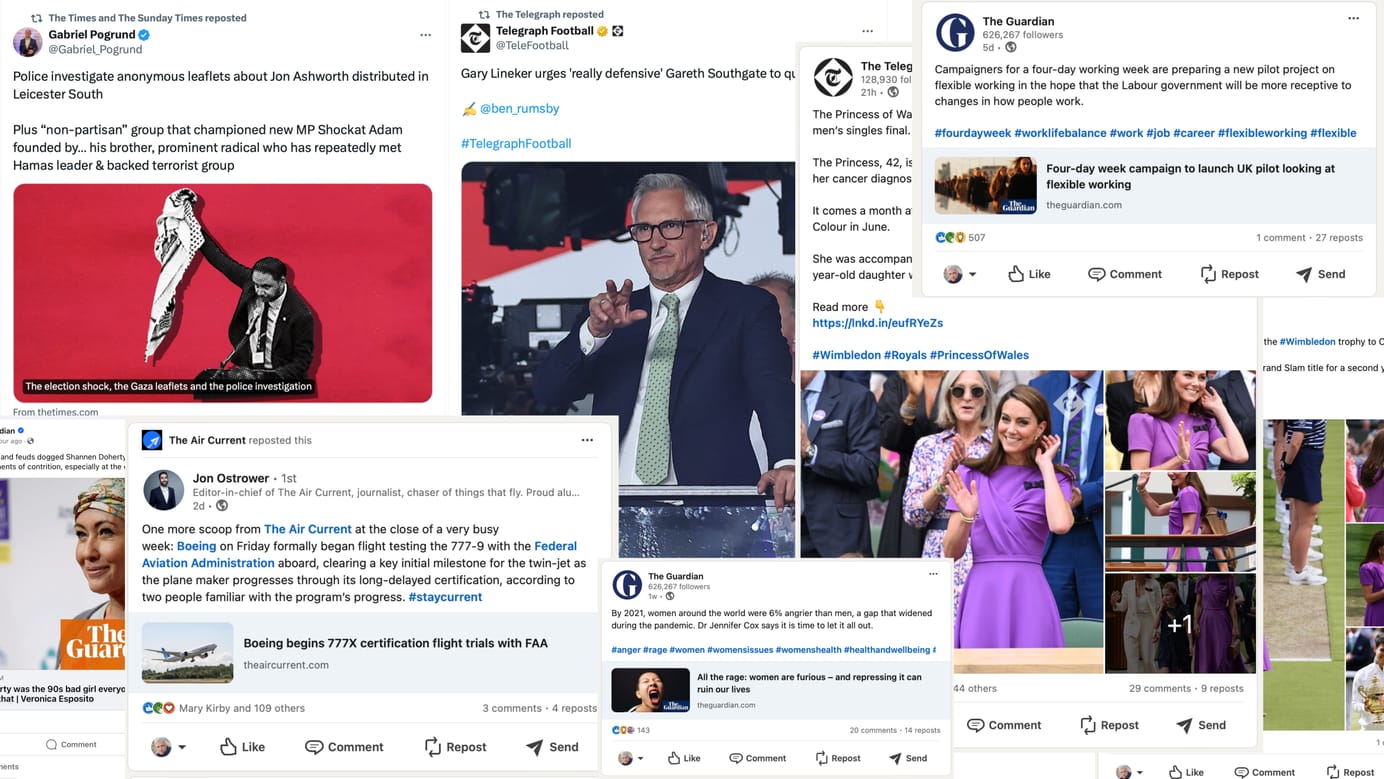
The new integration: newsroom and developers - #newsrw

A panel discussion on the digital future chaired by Katie King, senior product manager, Portal & Partners, MSN UK
Raju Narisetti, Wall Street Journal Digital
 If in 2012, if you’re still talking about integrating print and digital, you’re in deep, deep trouble. Good journalism matters – but experiencing that content matters even more. Good content is a table stake. everyone has to have it.
If in 2012, if you’re still talking about integrating print and digital, you’re in deep, deep trouble. Good journalism matters – but experiencing that content matters even more. Good content is a table stake. everyone has to have it.
Digital audiences will be even more promiscuous than they are now. They can experience other brands with the click of a finger, and through what is coming to them via social. And the only growth they’re going to get from their businesses is from digital audiences.
In 2012, the definition of a journalist must include bringing people to their journalism. What will enable that? The winners and losers will be separated at the intersection of content and technology. It’s only the experience that will make them say “I enjoyed experiencing the oscars at the Wall Street Journal” – and come back.
Both journalists and coders think their work is “art” and the other’s work is just “stuff”. You need to integrate the development and newsroom teams. We tend to fall in love with tools and try to fit them into our work. We need to start with experiences and work back to the tools.
 Joanna Geary, The Guardian
Joanna Geary, The Guardian
There is only one newsroom in The Guardian. The plan has always been to embrace the future platforms for the audience. You can’t build a business model where the audiences are. The newsroom integrated in 2008 when they moved to Kings Place. This year they went truly digital first.
The majority of the newsroom is dedicated to getting stories out online. There’s a slow stream – focused on producing up to 30% of the newspaper’s content ahead of time. We get slightly excited by process change talking from print to digital. The process is great, but can really fall on their arse if you don’t get a cultural change.
There’s a real need for an understanding in newsrooms about what developers do. That’s a tough thing to crack. Bring eyeballs isn’t enough anymore – they might not know it’s our content. They might not care. We need to think of them as people and start building relationships with them.
We have done well at bringing people to our content – but we have no idea why them come back. And until we learn that, and scale that, we have a challenge on their hands. Is it the young journalists who are best at engaging with readers? Not always.
It’s not a split between dispassionate journalism and social media. People still talk to their sources. They now have community co-ordinators embedded on all their major desks. It’s about getting people to remember that this is part of their daily reality.
 Alex Gubbay, Johnston Press
Alex Gubbay, Johnston Press
At Johnston Press, the challenge of co-ordinating that journey across hundreds of newsrooms means we have to be more careful. If we rush headlong into all things digital, we over-expose the core aspects of the business: print. If we move too slowly, we get left behind and become irrelevant.
What I’ve learnt since joining JP from the BBC, is trying not to be too dogmatic about all the phrases of digital journalism. Get to the heart of the issue needs cracking: print cannot govern or dictate anything we do digitally. We have to value for it as long as it remains a core function, but we need to ensure there are no legacy thinking or workflows in our digital operation. Keep the legacy platform going for as long as possible, but make sure nothing we’re doing stops us progressing.
They’re up from 8m to 10m online audience in a year. Mobile is 26% of their traffic. And it’s a significantly different demographics – 60% 35 or younger. Tablets is still early days, but there are good signs. Apple and Amazon remain fantastic shop windows for them – they see spikes from featured apps on Newsstand.
Triggering competition between journalists is one good way of getting journalists to involve themselves in social media.
 Martin Fewell, Channel4 News
Martin Fewell, Channel4 News
A bit of a newcomer – only been in role for 14 years. As Ghandi said: to make a change, you need to be the change.* The Guardian* has given all its journalist tablets (Joanna seems confused by this) – we need to experience our journalism the way our audience do.
He doesn’t have a monetisation problem, so his remit is to maximise the audience of their journalism. They focus on their distinctive stories, and go into depth. They develop the personalities of the reporters through blogging and social media, and they target niches.
Ideas are king. Don’t spend too long thinking about strategy – get on and do it. He heard someone on the radio talking about how ready London is for the Olympics. How easy would it be to get to the Paralympics if you’re disabled – or anywhere around the UK. And that thought led to a series, with a great mixed skill team – cameramen, reporters, producers, social media people. They found powerful stories of lack of access around the country – No Go Britain. They had people live-tweeting their experiences.
The whole stream has been a great source of journalism they never expected, over print, TV, online, social media…. There was no boss saying “go do this”. Social media can help counter what’s called “succulent lamb journalism” in Scotland – journalists bought lovely meals by collapsing Rangers and not actually writing negative stories as a result.
Couldn’t get agreement about breaking news online or on TV. So, no rules. They decide as they go along. They did a lot around working practices in small groups, as well. His problem is keeping his journalists off Twitter, not getting them on there. All the journalists get the power of their digital profile. They all want blogs, they all want tablets…
Question from the BBC: Is your social media dulling the impact of your stories, or driving people to them? He’s not sure it’s either – it’s about maximising the buzz around the story; getting influencers and other reporters to say “hey, they’ve got something”, and then watch it, or catch up with it online. Yes, it’s a risk, but you reap rewards by building bigger social media buzz.
Q&A
Both Raju and Joanna suggest they are in danger of being swamped by tools and platforms – you need to have a strategy, and you need to experiment and understand early on. You need to encourage entrepreneurship, but be realistic, suggests Joanna – and the only way you can do that is by measuring. Alex suggests that disciple and rigour in regional press makes some of the decisions for them. They need things that fundamentally transform their business – but they do need to leave time to experiment, but they need things that will scale from The Scotsman to the Stornaway Gazette.
Very specifically on user-generated video, Martin has found it very “episodic” in its use. 7/7 bombings generated many videos and images. Weather stories are fantastic generators of video, as the Olympics might well be, but he was involved in an intense legal discussion about the International Olympic Committee‘s rules… It’s a great event to think, that aside. Find the right project – set up a project team if you can – or sometimes great entrepreneurial journalists will come and show you how to do it.
Stopping people reinventing the wheel is a bug challenge at The Guardian, says Joanna. They have lots and lots of ways of getting people involved internally, including a digital project talked about at morning conference twice a week. “Five minutes of honesty”. They have lunchtime sessions, and are planning on :”community clinics”. E-mails go around from the community team highlighting those who have done well.
Just because something new comes along doesn’t mean you need to use all of it. For example, says Raju, Google+’s hangout are of great value. You don’t have to use all of it.
Joanna highlights the difference between business press – who (in theory) know who their audience are – and nationals, who often don’t, and who need to figure that out.
Mark Jones from Reuters points out that many journalists feel uncomfortable with the idea of interacting with their audiences, and struggle to move from broadcast to network mindset. Alex thinks it absolutely matters. For regional press to succeed, they have to be at the heart of their communities – and that means explaining the principles of interaction to their journalists without using jargon. They need to understand it’s a non-negociable, but give them a range of ways of doing it.
Joanna thinks journalists get confused because of mixed messages. The priority benefit isn’t the finical one – it’s bringing more people to your story to make it better. That’s engagement in Alan’s mind. If you’re asking people to do new things, it’s incumbent on you to show them why it’s important. Get your engagement pompoms on.
Present company excepted – journalists are incredible vain. Celebrate the champions, and everyone else notices it, says Martin.
Sign up for e-mail updates
Join the newsletter to receive the latest posts in your inbox.










